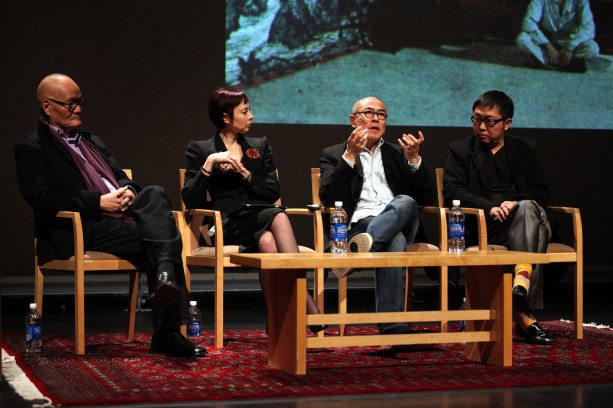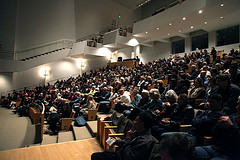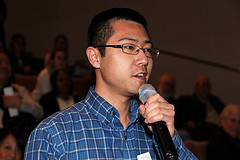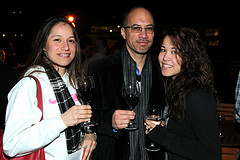
The population of Chinese artists has recently exploded. China supports about 20 art schools, with approximately 30,000 Chinese artists graduating per year. Socially, “to be an artist in China is a kind of privilege,” said artist Shengtian Zheng, who noted that artistry in China is “quite different” from that of Western society. But this fervor of activity and heightened status evolved alongside a tumultuous past.
“If we want to understand Chinese art now, we should know Chinese art from 30 years ago,” Zheng said. He was joined on a panel with USC School of Architecture Dean Qingyun Ma and New York-Shangai-based artist Wenda Gu at the Getty Center to discuss the New China, and the ruins of the old.
Moderator Melissa Chiu, director of the Asia Society Museum in New York, set up the evening as a historical narrative, weaving together politics and artistry to approach the issue.
Degrees of Censorship

During the 1950s and 60s, Zheng explained, artists were in an “ivory tower,” but work was still extremely controlled by the government. “Before the [Great Proletarian] Cultural Revolution you still couldn’t paint a nude model,” Zheng recalled.
When the Cultural Revolution broke out and students organized themselves into “Red Guard” factions, “for about a year, the whole country was in chaos,” Zheng said. When things first settled down, the artistic subjects were still very limited. “You had to do a Mao portrait or propaganda,” he recalled. Zheng showed a few slides of himself in 1967, working on a large billboard poster of Mao Zedong in Hangzhou.
An audience member later asked about current censorship and the Government’s pursuit of Chinese artist Ai Weiwei, known for his activism. While there may still be some political limitations, moderator Chiu said, “It’s nothing like it was. Artists could not show their work in a state-run museum or in a gallery.” Gu agreed that things had much improved, recalling the closure of his first solo gallery show when authorities weren’t able to decipher his intentions.
The New Wave

Unlike Zheng, Gu and Ma grew up after the Cultural Revolution. Gu became one of the main figures in the ’85 New Wave Art movement and Political Pop, exploring mixed media, installation, and ink painting. He became one of the first Chinese international artists.
Ma became one of the first Chinese architects in the 1980s. He grew up in the city of Xi’an, where, he joked, parents either “trained their kids in arts or martial arts,” depending on their social status. He said his family was “confused” because they had a military background, his father was poor, but his mother was from an educated family. “Architecture seems to be a continuation of that confusion,” he quipped.
Ma explained that architecture had always been done by the Ministry of Architecture or institutions, and private architecture was virtually unknown. He called Chinese architecture a “silent revolution” that was different from the art revolution in the way that it defined spaces and mobilized people in a “systematic, operational” way.
Influence of the Cultural Revolution (1966-1976)
“For the people who truly experienced the Cultural Revolution, that was a disastrous experience. But for us, we greatly benefited,” Gu admitted. It was the “awakening of individual thought.”
Ma echoed this sentiment, and added a curious twist. Part of Mao’s massive infrastructure reprogramming included the purging of intellectuals from universities and mobilizing the countryside. “Highly educated individuals were exiled to the countryside to teach people like me.” Ma believes he was reached and trained well “because of the dispersion of the educated minds into all the corners of China.”
The Red Guards also instituted honghaiyang, or the “Red Ocean”, where the whole country was painted in the color red. It lasted for 3 or 4 months, but it made a powerful impression on the children growing up at the time.
Gu showed a slide of his work, displaying a man sitting in front of a large red panel. “You can see the red very clearly,” Chiu commented. “This one is among the very beginning,” where people saw “art woven with the political image and the color,” Gu stated.
In the Middle Way

Each of the panelists embodied a duality of Western and Chinese culture, which they discussed as positively influencing their art. (Chiu noted they now all live abroad.) Ma went to college in the 1980s, and he remembers reading Kant and Nietzsche while attending a major exhibit.
Gu explained that importing Western culture was important to breaking barriers in the 1980s, but, in the end, he appreciated his traditional background. He feels too many contemporary artists lack the foundation he received, and the different “colors” or “counterparts” within himself provide unique perspective. His piece “Forest of Stone Steles” is indicative of this cultural “gray area.” He etched translations of English and Chinese into stone to accent how “mistranslation and misinterpretation of different cultures can create something new.”
The idea of China influencing Western art has also, more recently, become a valid concept, Gu stated. “We can’t just take the art of the West. We have to use the Chinese traditional culture to challenge the West.”
The crowd at the Getty, clearly sympathetic to the preservation of art and buildings, applauded a woman who asked a question regarding the erasure of past relics in favor of new developments. Fielding the architectural conundrum, Ma bluntly stated: “China is not afraid of losing old buildings.” He explained that tradition isn’t embedded in things; It’s beyond the physical constructs. “I use local labor, I pick stones from the river…it’s not a tradition, it’s the cheapest way to build it.”
Perhaps Chinese concepts of art, whether they are “traditional” or not, are challenging the West, after all.
The Getty’s exhibit, Photography from the New China runs through April 24, 2011
See more event photos here.
Watch a highlight of the conversation here.
Watch full video here.
Read the panelists’ “In the Green Room” Q&A’s: Melissa Chiu, Wenda Gu, Qingyun Ma, Shengtian Zheng
*Photos by Aaron Salcido




Send A Letter To the Editors